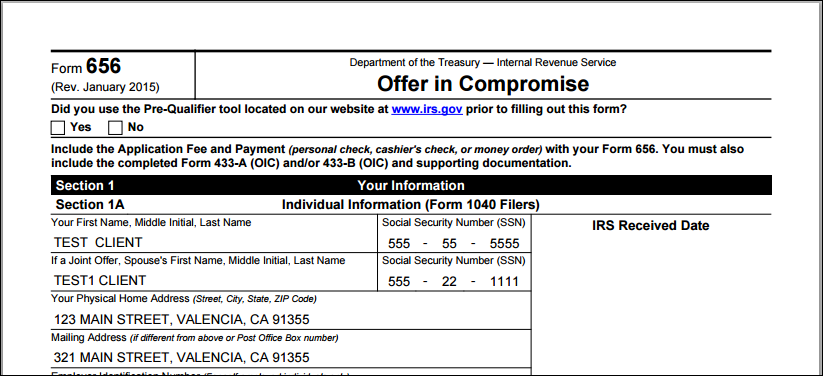If you want to know how you can file for an Offer In Compromise, below you will learn about what to do to get an IRS OIC for personal or business taxes.
See our video explanation of how to file for an offer in compromise if you prefer to watch it.
First Get The Correct Offer In Compromise Forms
First, you need to fill out the proper forms:
Form 433-A(OIC) for individuals or Form 433-B(OIC) for businesses. See our tax relief forms page to get the appropriate forms for your Offer In Compromise
This form is a financial statement. The IRS uses this to determine the collectibility of the person or business applying for a tax settlement. Sole Proprietorships should use Form 433-A(OIC).
Form 656 is the same form for both individuals and businesses
Here you put how much you are offering and payment details. Make sure to check for a fee and down payment waiver if you qualify and are applying as an individual. Businesses do not qualify for fee or down payment waivers.
Financial Documents for Individual OIC
At the end of Form 433-A(OIC) and Form 433-B(OIC) there is a list of all the documents that need to be submitted with an Offer In Compromise.
For individuals filing Form 433-A(OIC), these docs are:
- Copies of the most recent pay stub, earnings statement, etc., from each employer
- Copies of the most recent statement for each investment and retirement account
- Copies of the most recent statement, etc., from all other sources of income such as pensions, Social Security, rental income, interest and dividends (including any received from a related partnership, corporation, LLC, LLP, etc.), court order for child support, alimony, and rent subsidies.
- Copies of individual bank statements for the three most recent months. If you operate a business, copies of the six most recent statements for each business bank account.
- Copies of the most recent statement from lender(s) on loans such as mortgages, second mortgages, vehicles, etc., showing monthly payments, loan payoffs, and balances
- List of Notes Receivable, if applicable
- Verification of delinquent State/Local Tax Liability, if applicable
- Documentation to support any special circumstances described in the “Explanation of Circumstances” on Form 656,
- If applicable Attach a Form 2848, Power of Attorney, if you would like your attorney, CPA, or enrolled agent to represent you and you do not have a current form on file with the IRS.
- Completed and signed Form 656
Financial Documents for Business OIC
Here are the docs needed for a business filing IRS Form 433-B(OIC):
- A current Profit and Loss statement covering at least the most recent 6–12 month period, if appropriate
- Copies of the six most recent bank statements for each business account and copies of the three most recent statements for each investment and retirement accounts
- If an asset is used as collateral on a loan, include copies of the most recent statement from lender(s) on loans, monthly payments, loan payoffs, and balances
- Copies of the most recent statement of outstanding notes receivable
- Copies of the most recent statements from lenders on loans, mortgages (including second mortgages), monthly payments, loan payoffs, and balances
- Copies of relevant supporting documentation of the special circumstances described in the “Explanation of Circumstances” on Form 656, if applicable
- Attach a Form 2848, Power of Attorney, if you would like your attorney, CPA, or enrolled agent to represent you and you do not have a current form on file with the IRS. Make sure the current tax year is included.
- Completed and signed Form 656
Copy it all, mail it out USPS Certified with Return Receipt
Either scan up the entire package you are sending, or make a copy of it. Mail it out by USPS Certified Mail with a return receipt. Make a copy of the certified mail certificate, save the return receipt when you receive it.
You should get a letter back in about 30 days that the IRS is processing your offer. That letter will have a date on it by which they should be contacting you again.
If your case was in collections or assigned to a Revenue Officer, let them know you submitted an OIC. Then just wait for the OIC department’s response.
If you don’t want to do it yourself
If the task seems daunting or you just don’t want to do it yourself, we can help.
If you think you could benefit from the help of a tax attorney, schedule a consultation with one of our expert tax attorneys here or call us at (888) 515-4829.
We will give you an accurate assessment of whether you qualify for an Offer In Compromise or not. No sales gimmicks, just an honest opinion.
Sometimes Offers are not the best way to resolve a case. If you are not sure, have someone evaluate the options for you. I would not trust the opinion of a salesperson at a tax relief company.



I am really enjoying the theme/design of your website.
Do you ever run into any web browser compatibility problems?
A handful of my blog visitors have complained
about my website not operating correctly in Explorer
but looks great in Chrome. Do you have any ideas to help fix this issue?
Hey I know this is off topic but I was wondering if you knew of any widgets I could add to
my blog that automatically tweet my newest twitter updates.
I’ve been looking for a plug-in like this for quite some time and
was hoping maybe you would have some experience with something like this.
Please let me know if you run into anything. I truly enjoy reading
your blog and I look forward to your new updates.
I really like looking through a post that can make men and
women think. Also, thanks for permitting me to comment!
Excellent way of explaining, and pleasant post to take information concerning my presentation subject, which i am
going to deliver in institution of higher education.
This post provides clear idea in support of the new people of blogging, that in fact how
to do blogging and site-building.
You made some decent points there. I looked on the net
for more info about the issue and found most individuals will go along with your views on this website.
I’m amazed, I have to admit. Rarely do I come across a blog
that’s both equally educative and entertaining, and without a doubt,
you’ve hit the nail on the head. The issue
is something which too few people are speaking intelligently about.
I am very happy I came across this during my search for something concerning this.
magnificent publish, very informative. I wonder why the opposite experts of this sector do not realize this.
You must proceed your writing. I’m confident, you’ve a huge readers’ base already!
Quality articles or reviews is the main to be a focus
for the users to go to see the web page, that’s what this web page is providing.
I visit each day some sites and information sites to read posts, except this weblog offers
quality based writing.
Every weekend i used to visit this website, for the reason that i wish for enjoyment, as this this web page conations in fact good funny material too.
It is really a great and useful piece of info.
I’m glad that you shared this helpful information with
us. Please stay us informed like this. Thank you for sharing.
This is my first time pay a visit at here and i am really pleassant to read all at single place.
That is really interesting, You’re a very professional blogger.
I’ve joined your rss feed and look forward to searching for more of your magnificent post.
Also, I’ve shared your web site in my social networks
Here is my page – nordvpn coupons inspiresensation – t.co –
350fairfax nordvpn promotion
Spot on with this write-up, I absolutely feel this amazing site needs a great deal more
attention. I’ll probably be back again to read through more,
thanks for the info!
В этой статье представлен занимательный и актуальный контент, который заставит вас задуматься. Мы обсуждаем насущные вопросы и проблемы, а также освещаем истории, которые вдохновляют на действия и изменения. Узнайте, что стоит за событиями нашего времени!
Получить дополнительные сведения – https://nakroklinikatest.ru/
Spot on with this write-up, I really think this amazing site needs much more attention. I’ll probably
be back again to see more, thanks for the advice!
What a well-written article! I just came across a
company called Idal Glass, and I have too say, they rsally stand out in the marketplace of windows and doors.
They are experts in energy-efficient triple glazed
window installations, as well as slimline sliding
doors, and even intrernal screen systems for both domestic and businss needs.
I was impressed byy how they combine technical know-how with a foccus on energy efficiency.
It’s encouraging to know that companies like this onee are
helping people transform their spaces. This post, along with what I’ve seen from them, really maqkes me want to plzn some improvements to my ownn living space.
Looking forward to reading morde content lie this—thanks again ffor sharing!
Here is my web site … Clean-Pro
hi!,I love your writing very much! share we
communicate extra approximately your post on AOL?
I require a specialist on this space to resolve my problem.
May be that’s you! Having a look ahead to peer you.
I truly love your website.. Very nice colors & theme. Did you develop this amazing site yourself?
Please reply back as I’m trying to create my own site and
would like to know where you got this from or exactly what the theme is called.
Many thanks!
I read this post fully regarding the resemblance of hottest and previous technologies,
it’s amazing article.
my web site: eharmony special coupon code 2025